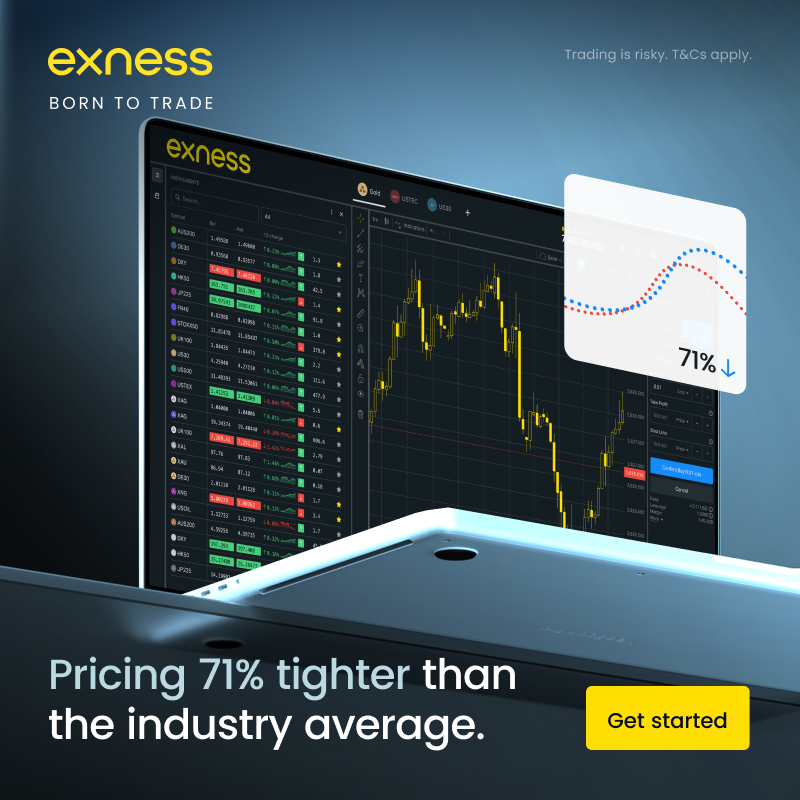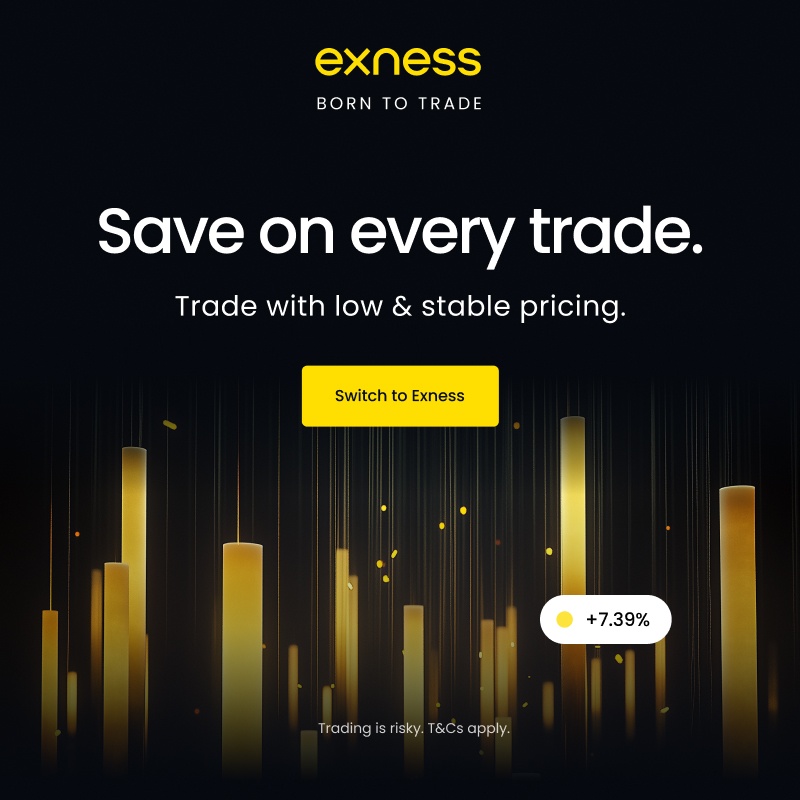
10 minute read
What is Spread in Exness? A Comprehensive Guide
from Exness
by Exness_Blog
In the world of forex and CFD trading, the term "spread" is one you’ll encounter frequently. It’s a critical factor that directly impacts your trading costs and profitability. If you’re considering trading with Exness, a globally recognized forex and CFD broker, understanding how spreads work on their platform is essential. In this comprehensive guide, we’ll dive deep into what spreads are, how Exness handles them, the types of spreads available, and how they affect your trading strategy. By the end, you’ll have a clear understanding of Exness spreads and how to leverage them for better trading outcomes.

💥 Trade with Exness now: Open An Account or Visit Brokers 🏆
What is a Spread in Forex Trading?
Before we explore spreads specifically on the Exness platform, let’s clarify what a spread is in forex trading. In simple terms, a spread is the difference between the bid price (the price at which you can sell a currency pair) and the ask price (the price at which you can buy a currency pair). This difference is typically measured in pips, which is the smallest price movement in forex trading.
For example, if the bid price for EUR/USD is 1.1000 and the ask price is 1.1002, the spread is 2 pips. The spread represents the cost of entering a trade, as you’re essentially paying the difference between the buying and selling price. A lower spread means lower trading costs, which is particularly important for high-frequency traders like scalpers or day traders.
Spreads are a primary way brokers like Exness generate revenue, as they often incorporate their fees into the spread rather than charging a separate commission. However, the size of the spread can vary based on several factors, including market conditions, account type, and the trading instrument.
Why Spreads Matter in Trading
Spreads are a crucial consideration for traders because they directly impact profitability. A narrower spread reduces the cost of entering and exiting trades, allowing traders to retain more of their profits. Conversely, wider spreads increase trading costs, which can eat into your earnings, especially for short-term trading strategies.
For example:
Scalpers, who execute multiple trades in a short period, rely on tight spreads to maximize profits on small price movements.
Long-term traders, who hold positions for days or weeks, may be less affected by spreads but still benefit from lower costs.
High-volatility markets can cause spreads to widen, increasing costs during economic news releases or low liquidity periods.
Understanding how spreads work and how they vary is key to choosing the right broker and account type for your trading style. Let’s now explore how Exness handles spreads and what makes their offering unique.
Spreads at Exness: An Overview
Exness is a well-established broker, founded in 2008, known for its competitive trading conditions, transparency, and wide range of trading instruments, including forex, commodities, cryptocurrencies, indices, and stocks. One of the standout features of Exness is its approach to spreads, which is designed to cater to different types of traders, from beginners to professionals.
Exness offers both dynamic (floating) spreads and stable (fixed) spreads, depending on the account type and trading instrument. Here’s a breakdown of how spreads work on the Exness platform:
1. Dynamic (Floating) Spreads
Dynamic spreads, also known as floating spreads, fluctuate based on market conditions such as volatility, liquidity, and trading activity. These spreads are typically tighter during high-liquidity periods (e.g., during the London and New York trading sessions) and may widen during low-liquidity periods or major economic news releases.
Advantages:
Tighter spreads during stable market conditions.
Reflect real-time market conditions, offering transparency.
Ideal for traders who can time their trades during high-liquidity periods.
Disadvantages:
Spreads can widen significantly during volatile periods, increasing trading costs.
Less predictable for budgeting trading expenses.
At Exness, dynamic spreads are available on accounts like the Standard and Pro accounts, making them suitable for a wide range of traders.
2. Stable (Fixed) Spreads
Stable spreads, or fixed spreads, remain constant regardless of market conditions. Exness offers fixed spreads on certain currency pairs, providing traders with predictable trading costs. These spreads are calculated using a weighted average of the spread and ticks over a specific timeframe.
Advantages:
Predictable trading costs, even during volatile market conditions.
Ideal for news traders or those who prefer consistency.
Disadvantages:
Fixed spreads are often higher than the lowest dynamic spreads during calm markets.
Limited to specific instruments.
Exness offers stable spreads on select currency pairs, which remain fixed for approximately 90% of the time, excluding periods of extreme market volatility.

💥 Trade with Exness now: Open An Account or Visit Brokers 🏆
3. Zero Spreads
Exness also offers Zero Spread accounts, such as the Zero and Raw Spread accounts, which are designed for traders seeking the lowest possible trading costs. On these accounts, certain instruments (e.g., the top 30 currency pairs) have zero spreads for a significant portion of the trading day. However, a fixed commission is charged per trade instead.
Advantages:
Extremely low or no spreads on major instruments.
Ideal for scalpers and algorithmic traders who need minimal trading costs.
Disadvantages:
Commissions apply, which may offset the cost savings for some traders.
Zero spreads are not available for all instruments (e.g., exotic pairs like AUDDKK or individual stocks may have spreads).
How to Check Spreads on Exness
Exness provides several ways to check spread values, ensuring transparency for traders:
Exness Website: The website lists average spreads for the previous trading day. Note that these are estimates and may differ from real-time spreads on the trading platform.
Exness Terminal: Log into your Personal Area (PA), select an MT5 account, and navigate to the Exness Terminal. Under “Instruments,” toggle the “Spread” option to view current spreads.
MetaTrader 4/5 (MT4/MT5): In the Market Watch window, right-click and select “Spread” to display the exact spread for each instrument in real-time.
Spreads for major, minor, and exotic currency pairs are shown in pips, while spreads for cryptocurrencies, energies, indices, and stocks are displayed in pips and the quote currency.
Factors Influencing Spreads at Exness
Several factors influence the size of spreads on the Exness platform. Understanding these can help you anticipate changes and optimize your trading strategy:
1. Market Volatility
High volatility, often triggered by economic news releases, geopolitical events, or central bank decisions, can cause spreads to widen. For example, during major announcements like U.S. Non-Farm Payrolls or Federal Reserve interest rate decisions, spreads may increase temporarily due to rapid price movements.
Tip: Use Exness’s Economic Calendar to stay informed about upcoming events that could impact spreads.
2. Liquidity
Spreads are narrower when market liquidity is high, such as during overlapping trading sessions (e.g., London-New York). Conversely, spreads may widen during off-peak hours or for less-traded instruments like exotic currency pairs.
Tip: Trade during peak market hours to benefit from tighter spreads.
3. Trading Instrument
The type of instrument you trade affects the spread. Major currency pairs like EUR/USD and GBP/USD typically have the tightest spreads due to their high trading volume. Exotic pairs, such as USD/TRY or AUD/DKK, often have wider spreads due to lower liquidity.
Tip: Focus on major pairs for lower trading costs, especially if you’re a beginner.
4. Account Type
Exness offers several account types, each with different spread structures:
Standard Account: Low spreads with no commissions, suitable for beginners.
Pro Account: Tighter spreads than the Standard account, with no commissions, ideal for experienced traders.
Zero Account: Zero spreads on top instruments with a fixed commission, perfect for scalpers.
Raw Spread Account: Ultra-low spreads with a small commission, balancing cost and flexibility.
Choosing the right account type depends on your trading strategy and risk tolerance.
How Exness Spreads Compare to Other Brokers
Exness is known for offering some of the most competitive spreads in the industry. For example, the EUR/USD spread on the Zero or Raw Spread accounts can be as low as 0.0 pips, which is highly attractive for scalpers and high-frequency traders. Compared to other brokers, Exness’s spreads are often lower, especially for major currency pairs.
However, it’s worth noting that spreads can vary based on market conditions, and some competitors may offer tighter spreads for specific instruments or under certain conditions. When comparing brokers, consider:
Spread Type: Fixed vs. floating.
Commissions: Exness offers commission-free accounts (Standard, Pro) and commission-based accounts (Zero, Raw Spread).
Additional Fees: Check for swap fees (overnight financing costs) or inactivity fees.
Exness’s hybrid model, combining features of market maker and ECN brokers, allows it to offer competitive pricing while maintaining flexibility. The broker’s transparency in displaying average spreads and real-time data further enhances its appeal.
Tips for Managing Spreads on Exness
To optimize your trading experience and minimize the impact of spreads, consider the following strategies:
Trade During High-Liquidity Periods: Focus on major market sessions (London, New York) when spreads are typically tighter.
Choose the Right Account Type: Select an account that aligns with your trading style (e.g., Zero account for scalping, Standard account for beginners).
Monitor Economic Events: Use Exness’s Economic Calendar to avoid trading during high-volatility periods when spreads may widen.
Use a Demo Account: Practice trading with a demo account to understand how spreads affect your strategy without risking real money.
Leverage Exness Tools: Use the Exness trading calculator to estimate pip values and trading costs for better planning.
Why Choose Exness for Low Spreads?
Exness stands out as a leading broker due to its commitment to competitive pricing and transparency. Here are some reasons why traders choose Exness for low spreads:
Regulation: Exness is regulated by top-tier authorities like the Financial Conduct Authority (FCA) in the UK, CySEC in Cyprus, and the Financial Sector Conduct Authority (FSCA) in South Africa, ensuring fair pricing practices.
Variety of Accounts: From commission-free Standard accounts to zero-spread professional accounts, Exness caters to all trader levels.
Fast Execution: Exness offers ultra-fast execution, minimizing slippage and ensuring you get the quoted spread.
Transparency: Real-time spread data and average spread information are readily available on the Exness website and trading platforms.
No Hidden Fees: Most accounts are commission-free, and Exness is upfront about any applicable charges.
Common Misconceptions About Exness Spreads
“Exness spreads are always the lowest.” While Exness offers competitive spreads, they can vary based on market conditions and account type. Always compare spreads for your specific trading instruments.
“Zero spreads mean no trading costs.” Zero Spread accounts charge a commission, which should be factored into your cost calculations.
“Spreads are the same on all platforms.” Spreads on the Exness website are shown in pips, while MT4/MT5 displays them in points (1 pip = 10 points). Always verify real-time spreads on your trading platform.
Conclusion
Understanding spreadseref on Exness is key to optimizing your trading strategy and minimizing costs. Whether you’re a scalper seeking zero spreads, a day trader looking for tight dynamic spreads, or a long-term trader prioritizing stable spreads, Exness offers a range of account types and tools to suit your needs. By choosing the right account, timing your trades strategically, and staying informed about market conditions, you can make the most of Exness’s competitive spreads.
💥 Note: To enjoy the benefits of the partner code, such as trading fee rebates, you need to register with Exness through this link: Open An Account or Visit Brokers 🏆
Read more:




